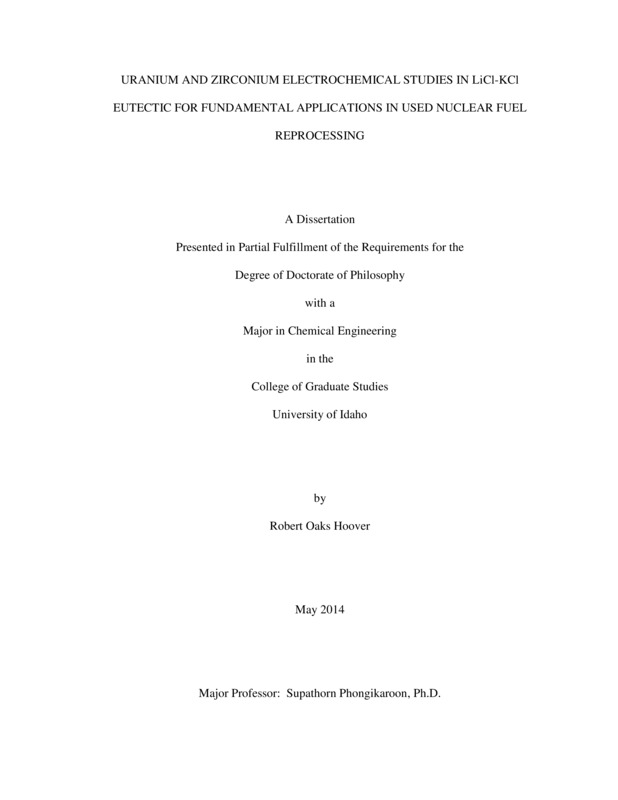URANIUM AND ZIRCONIUM ELECTROCHEMICAL STUDIES IN LiCl-KCl EUTECTIC FOR FUNDAMENTAL APPLICATIONS IN USED NUCLEAR FUEL REPROCESSING
Hoover, Robert O.. (2014). URANIUM AND ZIRCONIUM ELECTROCHEMICAL STUDIES IN LiCl-KCl EUTECTIC FOR FUNDAMENTAL APPLICATIONS IN USED NUCLEAR FUEL REPROCESSING. Theses and Dissertations Collection, University of Idaho Library Digital Collections. https://www.lib.uidaho.edu/digital/etd/items/hoover_idaho_0089e_10310.html
- Title:
- URANIUM AND ZIRCONIUM ELECTROCHEMICAL STUDIES IN LiCl-KCl EUTECTIC FOR FUNDAMENTAL APPLICATIONS IN USED NUCLEAR FUEL REPROCESSING
- Author:
- Hoover, Robert O.
- Date:
- 2014
- Program:
- Chemical Engineering and Materials Engineering
- Subject Category:
- Nuclear chemistry
- Abstract:
-
Measurement and analysis of uranium (U) and zirconium (Zr) electrochemistry in the molten salt system are extremely important to the fundamental understanding of electrochemical processing of used nuclear fuel currently operated at the Idaho National Laboratory. Few studies have been performed in the past with U and Zr at concentrations approaching those in the electrorefiner. For this main reason, a set of experiments, including cyclic voltammetry (CV), chronopotentiometry, and anodic stripping voltammetry (ASV), has been performed to explore different parameters in a system that are common to the electrorefiner's conditions. U experiments were performed at 773 K with concentrations from 1.0 to 10.0 wt% UCl3 in the LiCl-KCl, while Zr behavior was studied under three different temperature (723, 773, and 823 K) and at varying concentrations from 0.5 to 5 wt% ZrCl4. An additional set of experiments with UCl3-ZrCl4-LiCl-KCl was also performed to explore the behavior of these two species together. ASV and CV were analyzed as possible
in-situ methods for analyzing concentration, with CV cathodic data showing the most promise.From these experiments, diffusivity (D), apparent standard reduction potential (E
0* ), and activity coefficients (γ) were calculated. The values for D and E0* versus the Cl2/Cl- reference were determined to be:773 K: DU(IV) = 1.26 × 10
-5 cm2 /s E0* U(IV)/U(III) = -1.453 VDU(III) = 2.16 × 10
-5 cm2 /s E0* U(III)/U = -2.552 V723 - 823 K: DZr(IV) = 4.60 × 10
-4 exp(-3716/T) E0* Zr(IV)/Zr(II) = 0.002T - 3.508DZr(II) = 0.027exp(-5619/T) E
0* Zr(II)/Zr = 0.0007T - 2.908Calculation of the E
0* values required the standard rate constant (ks) which was not known for Zr. The results reveal that there is a weak effect of ks on E0* ; for the current purpose, the value for U(III)/U has been used to facilitate the discussion. It appears that γ values vary significantly depending on different used thermodynamic databases. Results from the combined UCl3-ZrCl4 study provide some insight to Zr recovery in the presence of UCl3. The CV data appear to show that Zr(II) may not fully reduce to Zr metal, forming instead ZrCl, which may be a possible impediment to electrorefining pure Zr metal. - Description:
- doctoral, Ph.D., Chemical Engineering and Materials Engineering -- University of Idaho - College of Graduate Studies, 2014
- Major Professor:
- Phongikaroon, Supathorn
- Committee:
- Allahar, Kerry; Paviet, Patricia; Utgikar, Vivek
- Defense Date:
- 2014
- Identifier:
- Hoover_idaho_0089E_10310
- Type:
- Text
- Format Original:
- Format:
- application/pdf
- Rights:
- In Copyright - Educational Use Permitted. For more information, please contact University of Idaho Library Special Collections and Archives Department at libspec@uidaho.edu.
- Standardized Rights:
- http://rightsstatements.org/vocab/InC-EDU/1.0/

